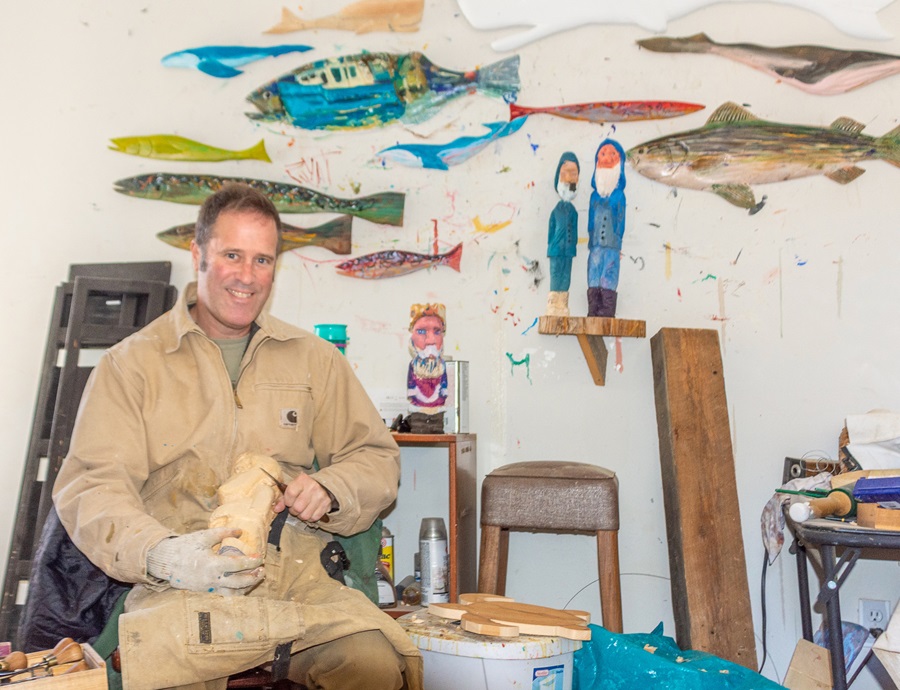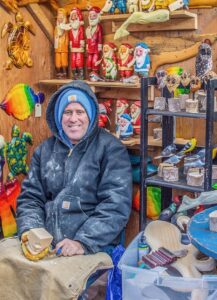Woodcarver Rob Scott’s winter studio on Conwell Street in Provincetown is like an extension of the hardware store next door — if a Carhartt-enthused Geppetto fascinated by saltwater aquariums were creative director of its back room.
Planks reclaimed from a house built in 1775 and from the now-shuttered Commercial Street fixture Hersheldon’s Leather are among Scott’s supplies, along with lengths of wood sourced online and chunks from another woodcarver up Cape.

On a workbench set against one wall is a collection of essential tools that sound like the names of forgotten heavy metal bands: palm gouges, knives, Saburrtooth burrs, a Dremel, and a die grinder. A series of abstract paintings Scott composed from leftover paint are on the wall above the bench.
Scott’s creations conjure an array of sea creatures, real and imagined. A naked whale and a school of painted fish swim across another whitewashed wall while a half-carved octopus perches near Scott’s feet on the cool expanse of wood-dusted concrete. Four fishermen in yellow-painted raincoats line up, side by side, on a shelf. There are mermaids.
The bulbous nose and strong jaw of an odd figure emerges from a large block of cedar stationed under the window — a few Santa Clauses round out Scott’s winter work.

The Boston-born Scott, a painter by training, a woodcarver by trade, and the self-proclaimed “late night king” of MacMillan Pier, came to Provincetown for a summer job in 1991 after finishing his B.F.A. in painting at Temple University in Philadelphia. He has been here every summer, and more when he can. He says the Outer Cape reminds him of childhood summers spent with his grandmother on the Jersey Shore.
Crowned by a slouchy beanie, he has the wind-chapped vitality of someone who spends a lot of time outdoors. The T-shirt under a paint-splattered canvas jacket strengthens this impression: on it, Henry David Thoreau is pictured above the words “Keep Calm and Saunter On.”
But Scott passes most of his off-season days carving and painting in this room. Occasionally he moonlights as singer and keyboardist for the Grab Brothers, a local band that performs covers and originals spanning genres from classic rock to hip-hop. Scott also holds a master’s degree in modern American music from the Longy School in Cambridge.
Scott says that the winter allows him to explore new ideas and build his inventory away from the outcome-oriented pressures of the summer and holiday seasons when he sells at the pier and the Canteen holiday market. He works on several projects at once, taking his time to uncover the unique grain and shape within each type of wood.
“It’s kind of like growing crops,” says Scott. “You take what it gives you.”
Scott is fond of metaphor and sprinkles his speech with quotes he attributes to Michelangelo, his old piano teacher, and Clint Eastwood. “You don’t want to let the old man in,” he says, an Eastwood-esque statement of his commitment to exploring different art forms.
Except for a stint in college studying stone sculpture in Italy with Peter Rockwell, a son of Norman Rockwell who spent most of his adult life in Rome, Scott came to sculpting and to wood as a medium only in the last decade. About eight years ago, he was painting houses in Hingham when a client introduced him to woodcarving.
“Twenty minutes in, I was like ‘I want to do this,’ ” says Scott. “When I work with wood, I feel like I’m connected to something ancient. Unlike clay, it’s subtractive. You can’t get it back once you take it away.”
He returned to Provincetown and, with the guidance of other carvers, online videos, and books about carving as a folk tradition, he started to produce his own body of work.
After his first group show at Spiritus Pizza in 2015, he sat at the bar to calculate his earnings. He says the stack of bills that show brought in was big enough that he kept losing count — he made over $1,000. The experience pushed him to keep on carving. Soon he was accepted to the Trap Shed Program at MacMillan Pier run by the Provincetown Public Pier Corp. as a boost to crafters.
Having a shed means working 12-hour days May through October. It also means getting to know other makers. Last season, Scott started a collaboration with the artist Lena Wallace, his neighbor on the pier. She adds resin pours in shades of blue to his carvings of whales and fish.
Tracing the outline of a set of sea turtles he cut out earlier in the day, Scott says each one of the figures he carves has a different personality that doesn’t have much to do with him. A glance around the room brings a visitor into the watchful gaze of the little spirits he has conjured.
“People walk past me all the time on the pier and say, ‘This is a dying art,’ ” says Scott. “I always respond: ‘It’s a living art.’ ”



